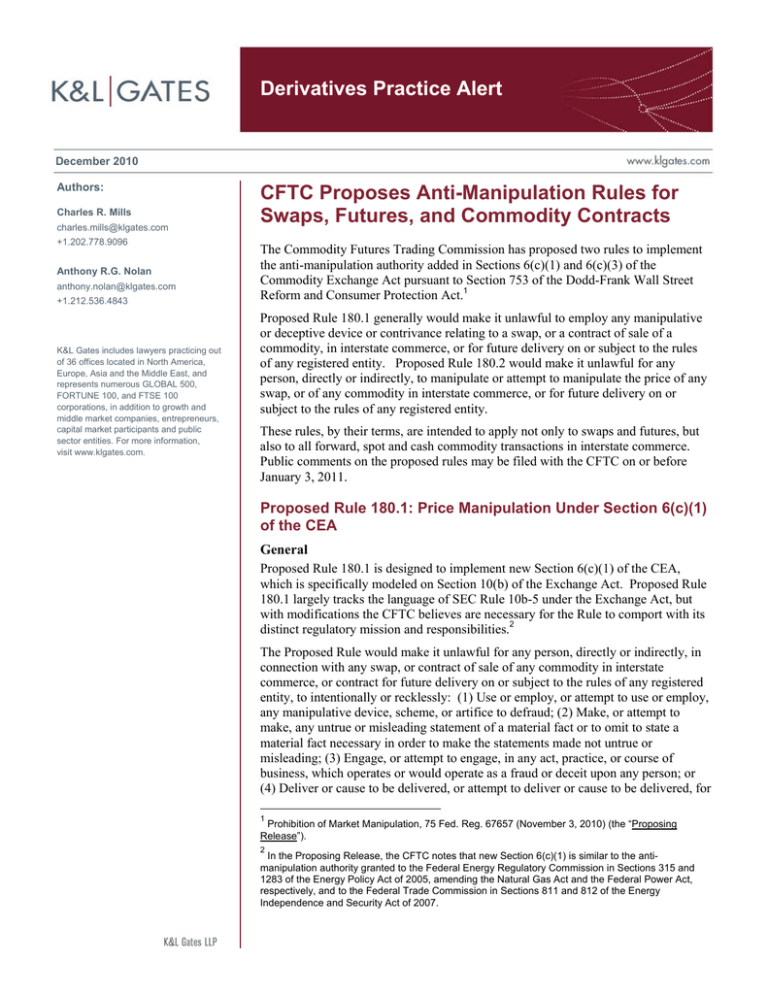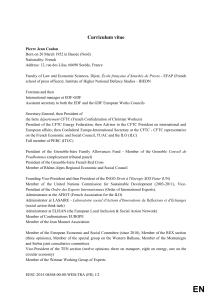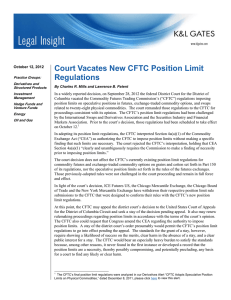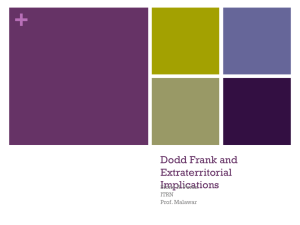
Derivatives Practice Alert
December 2010
Authors:
Charles R. Mills
charles.mills@klgates.com
+1.202.778.9096
Anthony R.G. Nolan
anthony.nolan@klgates.com
+1.212.536.4843
K&L Gates includes lawyers practicing out
of 36 offices located in North America,
Europe, Asia and the Middle East, and
represents numerous GLOBAL 500,
FORTUNE 100, and FTSE 100
corporations, in addition to growth and
middle market companies, entrepreneurs,
capital market participants and public
sector entities. For more information,
visit www.klgates.com.
CFTC Proposes Anti-Manipulation Rules for
Swaps, Futures, and Commodity Contracts
The Commodity Futures Trading Commission has proposed two rules to implement
the anti-manipulation authority added in Sections 6(c)(1) and 6(c)(3) of the
Commodity Exchange Act pursuant to Section 753 of the Dodd-Frank Wall Street
Reform and Consumer Protection Act.1
Proposed Rule 180.1 generally would make it unlawful to employ any manipulative
or deceptive device or contrivance relating to a swap, or a contract of sale of a
commodity, in interstate commerce, or for future delivery on or subject to the rules
of any registered entity. Proposed Rule 180.2 would make it unlawful for any
person, directly or indirectly, to manipulate or attempt to manipulate the price of any
swap, or of any commodity in interstate commerce, or for future delivery on or
subject to the rules of any registered entity.
These rules, by their terms, are intended to apply not only to swaps and futures, but
also to all forward, spot and cash commodity transactions in interstate commerce.
Public comments on the proposed rules may be filed with the CFTC on or before
January 3, 2011.
Proposed Rule 180.1: Price Manipulation Under Section 6(c)(1)
of the CEA
General
Proposed Rule 180.1 is designed to implement new Section 6(c)(1) of the CEA,
which is specifically modeled on Section 10(b) of the Exchange Act. Proposed Rule
180.1 largely tracks the language of SEC Rule 10b-5 under the Exchange Act, but
with modifications the CFTC believes are necessary for the Rule to comport with its
distinct regulatory mission and responsibilities.2
The Proposed Rule would make it unlawful for any person, directly or indirectly, in
connection with any swap, or contract of sale of any commodity in interstate
commerce, or contract for future delivery on or subject to the rules of any registered
entity, to intentionally or recklessly: (1) Use or employ, or attempt to use or employ,
any manipulative device, scheme, or artifice to defraud; (2) Make, or attempt to
make, any untrue or misleading statement of a material fact or to omit to state a
material fact necessary in order to make the statements made not untrue or
misleading; (3) Engage, or attempt to engage, in any act, practice, or course of
business, which operates or would operate as a fraud or deceit upon any person; or
(4) Deliver or cause to be delivered, or attempt to deliver or cause to be delivered, for
1
Prohibition of Market Manipulation, 75 Fed. Reg. 67657 (November 3, 2010) (the “Proposing
Release”).
2
In the Proposing Release, the CFTC notes that new Section 6(c)(1) is similar to the antimanipulation authority granted to the Federal Energy Regulatory Commission in Sections 315 and
1283 of the Energy Policy Act of 2005, amending the Natural Gas Act and the Federal Power Act,
respectively, and to the Federal Trade Commission in Sections 811 and 812 of the Energy
Independence and Security Act of 2007.
Derivatives Practice Alert
transmission through the mails or interstate
commerce, by any means of communication
whatsoever, a false or misleading or inaccurate
report concerning crop or market information or
conditions that affect or tend to affect the price of
any commodity in interstate commerce, knowing, or
acting in reckless disregard of the fact that such
report is false, misleading or inaccurate.
that comports with the purposes of the CEA and
the functioning of the markets regulated by the
CFTC.” The Proposing Release is silent as to
what modifications to securities law precedent
for recklessness are needed for CFTC regulated
markets.
Significantly, Proposed Rule 180.1 would not
impose a duty to disclose non-public market
information. The Proposing Release expressly
provides that the Rule would not create a new
or independent obligation to disclose nonpublic
market information; instead disclosure
obligations would arise only to the extent
necessary to prevent a person’s statement from
being misleading: “Nothing in this section shall
be construed to require any person to disclose to
another person nonpublic information that may
be material to the market price, rate, or level of
the commodity transaction, except as necessary
to make any statement made to the other person
in or in connection with the transaction not
misleading in any material respect.”
Securities Law Analogy
The CFTC’s application of SEC Rule 10b-5
standards to Rule 180.1 is summarized below.
•
•
The “in connection with” element. The CFTC
proposes that the words “in connection with” in
CEA Section 6(c)(1) and Proposed Rule 180.1
be given the same meaning as in Section 10(b)
of the Exchange Act and SEC Rule 10b-5 – that
is, conduct will be within the reach of the
Proposed Rule “where the scheme to defraud
and the transactions subject to the jurisdiction of
the CFTC ‘coincide.’” The Proposing Release
states that this requirement would be satisfied
“whenever misstatements or other relevant
conduct are made in a manner reasonably
calculated to influence market participants.”
The scienter element. The Proposing Release
declares that, as is the case for Rule 10b-5,
“scienter” for Proposed Rule 180.1 refers to “a
mental state embracing an intent to deceive,
manipulate or defraud,” and that recklessness
would suffice, but not negligence or gross
negligence. Significantly, Proposed Rule 180.1
expressly provides that good faith mistakes in
price reporting are not violations: “No violation
of Proposed Rule 180.1 shall exist where the
person mistakenly transmits false or misleading
information to a price reporting service in good
faith.”
Interestingly, the Proposing Release does not
define “recklessness” under Proposed Rule
180.1. Rather, the Proposing Release states that,
while the precedent interpreting SEC Rule 10b5 (which includes a well-established standard
for recklessness) should “guide” the application
of the scienter standard for Proposed Rule
180.1, it is not controlling and that the CFTC
should be given “sufficient leeway” to permit
application of a scienter standard “in a manner
•
The materiality element. The Proposing
Release states that the standard for materiality
should be objective rather than subjective, i.e.,
that a fact will be material based on whether a
reasonable person would have considered the
fact to be material. The Proposing Release,
borrowing from securities law precedent,
explains that an omission should be considered
material if there is a substantial likelihood that
the omitted fact would have been viewed by a
reasonable person as having significantly
altered the total mix of information available.
The Proposing Release declares that statements
of optimism alone (i.e., “puffery”) are not
material.
•
Reliance, loss causation, and damages. The
Proposing Release specifically states that
elements of reliance, loss causation, and
damages are not necessary to establish a
violation of CEA Section 6(c)(1) or Proposed
Rule 180.1 in a CFTC enforcement action. The
CFTC reasons that those are elements of private
claims of securities law violations, but not of
SEC enforcement actions. The CFTC notes,
however, such elements may be relevant in any
December 2010
2
Derivatives Practice Alert
CFTC determination of the appropriate penalty
or remedy for a violation.
Proposed Broad Construction
The Proposing Release advocates that Section
6(c)(1) of the CEA (and by implication Proposed
Rule 180.1) should “be given a broad, remedial
reading, embracing the use or employment, or
attempted use or employment, of any manipulative
or deceptive contrivance for the purpose of
impairing, obstructing, or defeating the integrity of
the markets subject to the jurisdiction of the
[CFTC].” The full breadth of this construction,
however, does not appear to be in keeping with
Supreme Court interpretations of Section 10(b) of
the Exchange Act, which hold that deception (i.e., a
material misrepresentation or actionable omission) is
a necessary element of any violation of that Section
and Rule 10b-5 thereunder and that those provisions
do not extend to mere unfair or overreaching
conduct.
The breadth of Rule 180.1 also is reflected in the
CFTC’s intent that it would prohibit “attempted
manipulation,” the elements of which would be “(1)
the requisite intent and (2) an overt act in
furtherance of that intent.”3
Proposed Rule 180.2: Price
Manipulation Under Section 6(c)(3) of
the CEA
The text of Proposed Rule 180.2 exactly repeats the
proscription of new Section 6(c)(3) of the CEA,
which itself tracks the language of the longstanding
general criminal anti-manipulation proscription in
CEA Section 9(a)(2). Proposed Rule 180.2 and
Section 6(c)(3) thus each declare it unlawful for any
person, directly or indirectly, to manipulate or
attempt to manipulate the price of any swap, or of
any commodity in interstate commerce, or for future
delivery on or subject to the rules of any registered
entity. The Proposing Release states that, after the
final rule is adopted, the CFTC would “continue
interpreting the prohibition on price manipulation
and attempted price manipulation to encompass
3
The SEC has recently separately proposed its own antimanipulation rule for security-based swaps under Section 9 of
the Exchange Act. To access our Client Alert on the SEC’s
proposed rule click here.
every effort to improperly influence the price of a
swap, commodity, or commodity futures contract.”
However, it does not delineate what an “improper”
influence is; nor does it explain why a rule that
merely repeats a statutory proscription is necessary.4
The CFTC intends that Proposed Rule 180.2 would
prohibit “every effort to influence the price of a
swap, commodity, or commodity futures contract
that is intended to interfere with the legitimate
forces of supply and demand in the marketplace.”
The Proposing Release, however, does not delineate
what the “legitimate” forces of supply and demand
are. The Proposing Release acknowledges that
manipulation cases are fact-intensive and that the
law in this area will continue to evolve largely on a
case-by-case basis. Existing case law, however, is
widely considered, in the words of a relatively
recent Senate Report, to be “confusing and
contradictory.”
The Proposing Release specifies a four-part test for
liability under Proposed Rule 180.2: “(1) that the
accused had the ability to influence market prices;
(2) that the accused specifically intended to do so;
(3) that artificial prices existed; and (4) that the
accused caused the artificial prices.”5 The
Proposing Release also takes the position that fraud
or other illegality is not a necessary element of a
claim of manipulation under CEA Section 6(c)(3)
and Proposed Rule 180.2. This position, however,
also appears to be at odds with a number of court
decisions under CEA Section 9(a)(2).
4
The CFTC proposes Rule 180.2 appears to be based solely
on the CFTC’s general rulemaking authority in Section 8a(5)
of the CEA, not on its new, specific anti-manipulation
rulemaking authority in Section 6(c)(1). Its reliance on Section
8a(5) alone indicates that the CFTC may believe that
Proposed Rule 180.2 exceeds its rulemaking authority under
Section 6(c)(1).
5
This formulation does not appear to be consistent with a
number of key court decisions and could be viewed as
inconsistent with the CFTC’s own decision in In re Indiana
Farm Bureau Cooperative Association, Inc., which held that in
order to prove the intent element of a manipulation or
attempted manipulation under the CEA, “it must be proven
that the accused acted (or failed to act) with the purpose or
conscious object of causing or effecting a price or price trend
in the market that did not reflect the legitimate forces of supply
and demand influencing futures prices in the particular market
at the time of the alleged manipulative activity.” (Emphasis
added.)
December 2010
3
Derivatives Practice Alert
The Proposing Release notes that, in various
circumstances, extensive economic analysis may not
be necessary to demonstrate the existence of an
artificial price. It states that in various cases an
illegal effect on price may be “conclusively
presumed” from the nature of the conduct in
question and other factual circumstances, without
requiring expert economic analysis. One example
provided is where a market participant pays more
than it had to for a futures contract for the purpose of
causing the closing price to be at a higher level. The
CFTC states, however, that in other cases economic
analysis may be necessary to determine whether the
conduct in question actually caused an artificial
price.
Anchorage Austin Beijing Berlin Boston Charlotte Chicago Dallas Dubai Fort Worth Frankfurt Harrisburg Hong Kong London
Los Angeles Miami Moscow Newark New York Orange County Palo Alto Paris Pittsburgh Portland Raleigh Research Triangle Park
San Diego San Francisco Seattle Shanghai Singapore Spokane/Coeur d’Alene Taipei Tokyo Warsaw
Washington, D.C.
K&L Gates includes lawyers practicing out of 36 offices located in North America, Europe, Asia and the Middle East, and represents numerous
GLOBAL 500, FORTUNE 100, and FTSE 100 corporations, in addition to growth and middle market companies, entrepreneurs, capital market
participants and public sector entities. For more information, visit www.klgates.com.
K&L Gates comprises multiple affiliated entities: a limited liability partnership with the full name K&L Gates LLP qualified in Delaware and
maintaining offices throughout the United States, in Berlin and Frankfurt, Germany, in Beijing (K&L Gates LLP Beijing Representative Office), in
Dubai, U.A.E., in Shanghai (K&L Gates LLP Shanghai Representative Office), in Tokyo, and in Singapore; a limited liability partnership (also named
K&L Gates LLP) incorporated in England and maintaining offices in London and Paris; a Taiwan general partnership (K&L Gates) maintaining an
office in Taipei; a Hong Kong general partnership (K&L Gates, Solicitors) maintaining an office in Hong Kong; a Polish limited partnership (K&L
Gates Jamka sp.k.) maintaining an office in Warsaw; and a Delaware limited liability company (K&L Gates Holdings, LLC) maintaining an office in
Moscow. K&L Gates maintains appropriate registrations in the jurisdictions in which its offices are located. A list of the partners or members in each
entity is available for inspection at any K&L Gates office.
This publication is for informational purposes and does not contain or convey legal advice. The information herein should not be used or relied upon
in regard to any particular facts or circumstances without first consulting a lawyer.
©2010 K&L Gates LLP. All Rights Reserved.
December 2010
4



